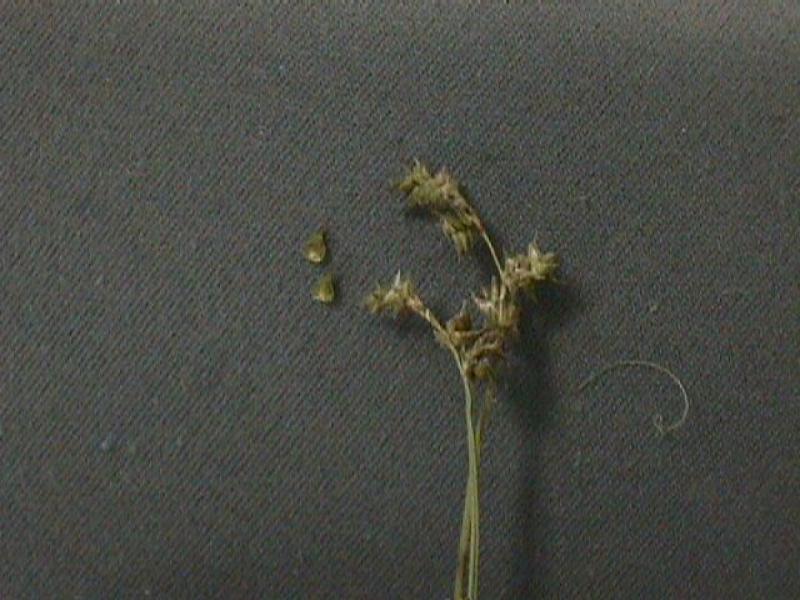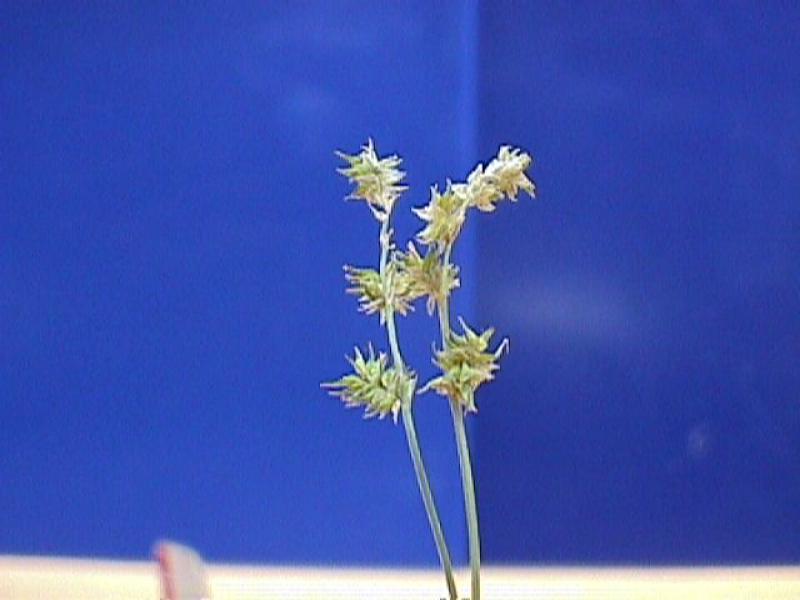Wiegand's Sedge
Carex wiegandii Mackenzie
- Class
- Monocotyledoneae (Monocots)
- Family
- Cyperaceae (Sedge Family)
- State Protection
- Endangered
Listed as Endangered by New York State: in imminent danger of extirpation in New York. For animals, taking, importation, transportation, or possession is prohibited, except under license or permit. For plants, removal or damage without the consent of the landowner is prohibited.
- Federal Protection
- Not Listed
- State Conservation Status Rank
- S1
Critically Imperiled in New York - Especially vulnerable to disappearing from New York due to extreme rarity or other factors; typically 5 or fewer populations or locations in New York, very few individuals, very restricted range, very few remaining acres (or miles of stream), and/or very steep declines.
- Global Conservation Status Rank
- G4G5
Apparently or Demonstrably Secure globally - Uncommon to common in the world, but not rare; usually widespread, but may be rare in some parts of its range; possibly some cause for long-term concern due to declines or other factors. More information is needed to assign either G4 or G5.
Summary
Did you know?
Carex wiegandii is named in honor of Karl McKay Wiegand (1873-1942), a major botanist from New York (Fernald 1970). Wiegand worked at Cornell University and the herbarium at Cornell is known as the Wiegand Herbarium.
State Ranking Justification
There are four known sites and only one historical location. These sites are in remote Adirondack and Tug Hill peatlands that face few to no threats and are within well-protected landscapes. This is a difficult to identify and difficult to locate sedge that may be overlooked. Other bog areas within the Adirondacks and Tug Hill should be surveyed with this sedge in mind.
Short-term Trends
Short term trends can not be assessed for populations in New York because there is not enough data available. Still, it is known that two populations have remained extant over the past twenty to thirty years.
Long-term Trends
There is very little historical data regarding C. wiegandii in New York. Therefore, long term trends are unknown.
Conservation and Management
Threats
Populations in New York are not directly threatened. Some of the populations are very small and although this species generally occurs like this throughout its range, small populations are inherently vulnerable to even small scale changes in the environment such as flooding or natural disturbances.
Conservation Strategies and Management Practices
Currently no management is needed for populations of C. wiegandii in New York.
Research Needs
Specimens from two sites need to be found and/or collected. They should be verified. Further survey work should be done to assess the full extent of populations.
Habitat
Habitat
In New York, Carex wiegandii occurs in acidic peatlands. It mostly occurs in the shade of conifers or alder thickets. It also is found in canopy openings and on the edge of open acidic peatlands. It occurs both on hummocks and depressions in these wetlands. The ground is usually carpeted with Sphagnum spp. (New York Natural Heritage Program 2006). It occurs in bogs, openings in acidic conifer, mixed, or alder swamps, and in wet acidic sandy or peaty meadows (Reznicek 2002). Sphagnum bogs and other wet, open places (Gleason and Cronquist 1991).
Associated Ecological Communities
- Black spruce-tamarack bog
(guide)
A conifer forest that occurs on acidic peatlands in cool, poorly drained depressions. The characteristic trees are black spruce and tamarack; in any one stand, either tree may be dominant, or they may be codominant. Canopy cover is quite variable, ranging from open canopy woodlands with as little as 20% cover of evenly spaced canopy trees to closed canopy forests with 80 to 90% cover.
- Highbush blueberry bog thicket*
(guide)
A wetland usually fed by rainwater or mineral-poor groundwater and dominated by tall shrubs and peat mosses. The most abundant shrub is usually highbush blueberry. The water in the bog is usually nutrient-poor and acidic.
- Inland poor fen*
(guide)
A wetland fed by acidic water from springs and seeps. Plant remains in these fens do not decompose rapidly and thus the plants in these fens usually grow on older, undecomposed plant parts of mostly sphagnum mosses.
- Patterned peatland
(guide)
A large peatland whose surface forms a gentle slope with a mosaic of high and low areas (relative to water levels). These high and low areas occur as narrow or broad bands of vegetation and pools that extend perpendicular to the direction of water flow across the slope of the peatland. Peat moss (Sphagnum) is the most abundant plant.
- Pine barrens vernal pond*
(guide)
A seasonally fluctuating pond and its associated wetlands that typically occurs in pine barrens. The water is intermittent, usually a pond in the spring but sometimes losing water through the summer to become a mostly vegetated wetland at the end of the summer. These ponds and wetlands may be small.
* probable association but not confirmed.
Associated Species
- Alnus incana
- Carex canescens
- Carex trisperma var. trisperma
- Larix laricina (tamarack)
- Osmunda cinnamomea
- Picea mariana (black spruce)
- Sphagnum spp.
- Viburnum nudum var. cassinoides (northern wild-raisin)
Range
New York State Distribution
Carex wiegandii is restricted to the northern Adirondacks (Lewis and Franklin Counties). New York is at the south edge of its range, although C. wiegandii is disjunct in northwestern Pennsylvania (Rhoads and Klein 1993).
Global Distribution
Carex wiegandii is considered a rare species with a relatively restricted range (Reznicek and Ball 1980). It occurs from Newfoundland and Labrador west to Ontario and Michigan south to Massachusetts, Vermont, and New York (Adirondacks). It is also disjunct in northwestern Pennsylvania (Reznicek and Ball 1980, Rhoads and Klein 1993, Reznicek 2002).
Identification Comments
General Description
Carex wiegandii is a grass-like tufted perennial. It has long strap-like leaves that are 1.7-5.0 mm wide. Numerous flowering/fruiting stems, 10-105 cm long, arise from the tufted leaves at the base of the plants. There are a few leaves on the stems and toward the tip of these stems are 4-6 flower/fruit clusters. These flower clusters have female flowers at the tip and male flowers at the base. The female flowers develop into fruits (perigynia) that are 2.6-3.8 mm long and 1.3-2.1 mm wide. Once mature the fruits easily fall from the plants (Reznicek 2002).
Identifying Characteristics
Carex wiegandii is a cespitose perennial. Leaves are 1.7-5.0 mm wide with the widest per plant 2.8-5.0 mm wide. The inflorescences are relatively dense being (0.8-)1.5-3.0 cm long and have 4-6 spikes. The proximal most internode is 1.3-9.5 mm long. Spikes are all gynecandrous with the terminal one having more staminate flowers at the base. Pistillate scales are 1.45-2.00(-2.20) mm long. Perigynia are 2.6-3.8 mm long and (1.3-)1.4-2.0(-2.1) mm wide. They have 5-18 veins abaxially and 0-10 faint veins adaxially. The beaks are 0.55-1.10(-1.35) mm long and are 0.25-0.55 times the length of the body (Reznicek 2002).
Best Life Stage for Proper Identification
The easiest time to identify C. wiegandii is when it is in fruit but the fruit are not yet easily shedding. Leaves are critical for identification and ideally a full specimen in fruit is needed for a correct determination to be made.
Similar Species
Carex wiegandii is a very distinctive member of section Stellulatae. When robust it is unmistakable (Reznicek and Ball 1980). The wide leaves, widest 2.8-5.0 mm, separates it from most other closely related species in New York. Carex echinata in New York, usually has widest leaves up to 2.7 mm wide but can occasionally have leaves that are a little bit wider. Carex echinata has perigynium beaks (0.85-)0.95-2.0 mm long; perigynia beaks (0.40-)0.45-0.86 times the length of the body; and pistillate scales of wide leaved individuals 2.1-3.1 mm long (Reznicek 2002).
Carex atlantica ssp. atlantica has widest leaves 1.6-4.0(-4.5) mm wide. It differs from C. wiegandii in having wider and wider to long perigynia. Carex atlantica ssp. atlantica has lower perigynia mostly 2.1-3.0 mm wide and mostly 1.1-1.7 times as long as wide vs. lower perigynia mostly 1.2-2.0 mm wide and mostly (1.5-)1.7-3.0 times as long as wide for C. wiegandii.
Best Time to See
Carex wiegandii is in immature to mature fruit from late June to early August although by late July the perigynia are starting to shed easily. Therefore, the best time to survey for this species is in the first two to three weeks of July.
- Fruiting
The time of year you would expect to find Wiegand's Sedge fruiting in New York.
Wiegand's Sedge Images
Images of Similar Species
Taxonomy
Wiegand's Sedge
Carex wiegandii Mackenzie
- Kingdom Plantae
- Phylum Anthophyta
- Class Monocotyledoneae
(Monocots)
- Order Cyperales
- Family Cyperaceae (Sedge Family)
- Order Cyperales
- Class Monocotyledoneae
(Monocots)
- Phylum Anthophyta
Additional Common Names
- Sedge
Comments on the Classification
Carex wiegandii is a member of section Stellulatae. It was first named in 1931 by Mackenzie (Reznicek 2002).
Additional Resources
Best Identification Reference
Reznicek, A.A. 2002. Carex Linnaeus sect. Stellulate Kunth. Pages 326-331 in Flora of North America Editorial Committee (editors), Flora of North America, North of Mexico, Volume 23, Magnoliophyta: Commelinidae (in part): Cyperaceae. Oxford University Press, New York, NY, USA. 608pp + xxiv.
Other References
Fernald, M.L. 1950. Gray's manual of botany. 8th edition. D. Van Nostrand, New York. 1632 pp.
Gleason, Henry A. and A. Cronquist. 1991. Manual of Vascular Plants of Northeastern United States and Adjacent Canada. The New York Botanical Garden, Bronx, New York. 910 pp.
Holmgren, Noel. 1998. The Illustrated Companion to Gleason and Cronquist's Manual. Illustrations of the Vascular Plants of Northeastern United States and Adjacent Canada. The New York Botanical Garden, Bronx, New York.
Mackenzie, K.K. 1931-1935. Cariceae. North American Flora 18: 1-478.
New York Natural Heritage Program. 2010. Biotics database. New York Natural Heritage Program. New York State Department of Environmental Conservation. Albany, NY.
New York Natural Heritage Program. 2024. New York Natural Heritage Program Databases. Albany, NY.
Reschke, Carol. 1990. Ecological communities of New York State. New York Natural Heritage Program, New York State Department of Environmental Conservation. Latham, NY. 96 pp. plus xi.
Reznicek, A.A. and P.W. Ball. 1980. The taxonomy of Carex section Stellulatae in North America north of Mexico. Contr. Unw. Mich. Herb. 14:153-203.
Rhoads, A.F., and W.M. Klein, Jr. 1993. The vascular flora of Pennsylvania: Annotated checklist and atlas. American Philosophical Society, Philadelphia, PA. 636 pp.
Rothrock, P.E. 1978. Carex wiegandii Mackenzie (Cyperaceae) New for Pennsylvania. Rhodora 80:451. A78ROT01PAUS.
Weldy, T. and D. Werier. 2010. New York flora atlas. [S.M. Landry, K.N. Campbell, and L.D. Mabe (original application development), Florida Center for Community Design and Research http://www.fccdr.usf.edu/. University of South Florida http://www.usf.edu/]. New York Flora Association http://newyork.plantatlas.usf.edu/, Albany, New York
Links
About This Guide
Information for this guide was last updated on: May 31, 2006
Please cite this page as:
New York Natural Heritage Program. 2024.
Online Conservation Guide for
Carex wiegandii.
Available from: https://guides.nynhp.org/wiegands-sedge/.
Accessed July 27, 2024.


